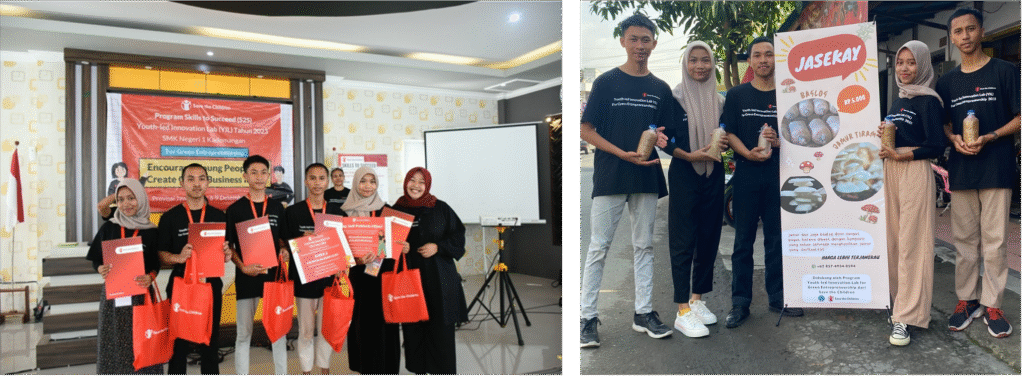
The Problem and Motivation Behind
“People were burning sawdust because they didn’t know what else to do with it. It made the air dirty, and our clothes smell bad. I wanted to change that,” Zhogina Dewasa Putra.
Zhogina Dewasa Putra (18-year-old) and his team grew up in a small furniture-producing village in Indonesia, where they witnessed firsthand how sawdust (wood waste) constituted an environmental challenge. Sawdust was carelessly burned, filling the air with harmful smoke and causing respiratory issues among residents. The burning of sawdust not only polluted the environment but also created an unpleasant smell that made daily life uncomfortable for their community.
“I saw piles of sawdust everywhere, and I thought—what if we could use this waste for something useful instead of burning it?” Zhogina recalls.
Zhogina and his team realised that sawdust burning was the norm because most people did not know how else to dispose of it. At the same time, local farmers in their area lacked access to sustainable fertilisers and often relied on expensive chemical alternatives, which further harmed the environment.
The Innovative Solution
“Before, we didn’t think much about the environment. But now, we see waste differently—we see business potential,” Zhogina says.
When Zhogina and his team joined Youth Innovation Lab, they chose to address the problem of sawdust, finding a solution to utilise them instead of burning. Through a Design Thinking process, they gathered information and generated multiple ideas on how to make use of sawdust. They found out an innovative solution of transforming sawdust into a planting medium for mushrooms. After harvesting the mushrooms, the used media is repurposed into organic fertiliser, ensuring nothing goes to waste. This innovative cycle not only reduces pollution but also provides healthy, sustainable food sources and organic fertilisers for farmers.
They developed a prototype for the process of transforming sawdust into a mushroom-growing medium and then fertilisers, as follow:
- Turning Sawdust into Planting Medium: Sawdust is processed and compacted into a suitable medium for growing mushrooms.
- Mushroom Cultivation: Mushrooms are grown in this medium, taking advantage of its natural properties.
- Producing Organic Fertiliser: Once the mushrooms are harvested, the used growing medium is repurposed as organic fertiliser, which is beneficial for local farmers.
Since starting, Zhogina and his team has achieved an 80% success rate in mushroom cultivation, proving that sawdust can serve as a reliable planting medium. They believe that their solution will significantly reduce sawdust burning, leading to cleaner air and less pollution in the village. It also promotes sustainable food production by providing low-cost, eco-friendly fertilisers. “It’s a complete cycle—nothing is wasted. From waste to food to fertiliser, everything goes back to nature,” Zhogina explains.
Through the support of the Youth Innovation Lab, Zhogina and his team gained essential skills in business development and green innovation. The lab provided guidance on how to structure their idea, manage resources efficiently, and create a business plan. They also learned effective marketing and branding techniques to promote their eco-friendly products.
Lessons Learned from Addressing Challenges
- Overcoming scepticism by hands-on demonstration: At first, many community members did not believe that mushrooms could grow on sawdust and were hesitant to buy. To address this, Zhogina and his team conducted demonstrations, showing the growing process and the quality of the mushrooms. These hands-on sessions helped change perceptions, and as people saw the mushrooms thriving, they became more interested. “People were unsure at first, but once they saw the mushrooms growing, they became curious and wanted to try them,” Zhogina notes.
- Managing production challenges: The team faced issues with unpredictable weather, which affected mushroom growth. They adapted by experimenting with different cultivation methods and creating controlled growing environments.
- Balancing studies and business: As students, balancing academic responsibilities with running Jasekay was difficult. To manage time effectively, the team established a clear schedule, and divided tasks based on availability.
- Building community support through informing: The team used social media platforms and word-of-mouth to promote their product. By informing the community on the environmental and economic benefits, they gradually built a customer base and encouraged more youth to get involved.
Next Steps and Future Aspirations
“If we can do this in our village, other communities can do it too. We want to inspire more people to think differently about waste,” Zhogina shares.
Zhogina and his team aim to make their solution a leading model for sustainable agriculture in their region. Their future plans include:
- Scaling Production: Improving techniques to increase mushroom yield.
- Expanding Fertiliser Sales: Partnering with more farmers to distribute organic fertiliser.
- Reaching New Markets: Extending sales to supermarkets and online platforms.
- Training More Youth: Training young people on how to turn waste into business opportunities.